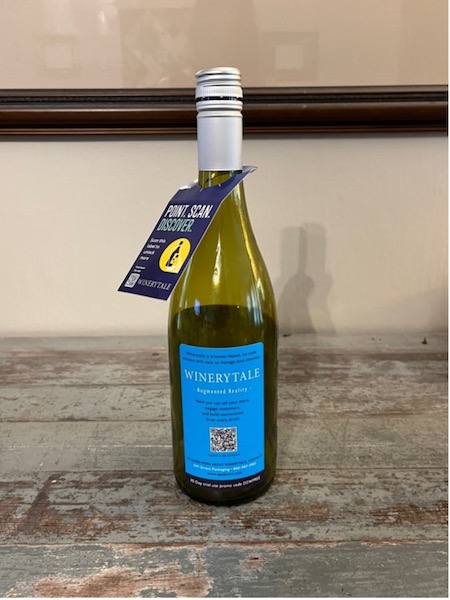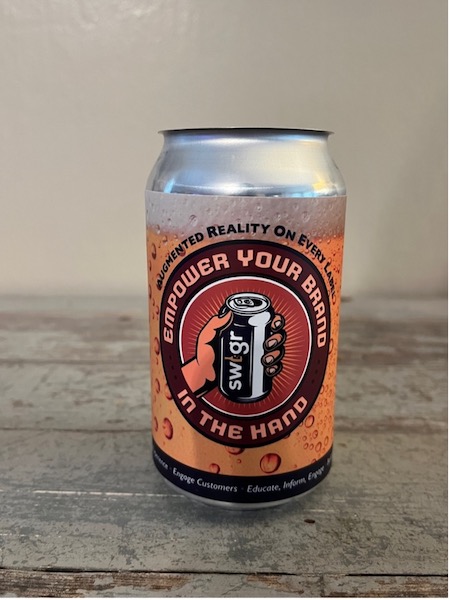Point your phone at an image, and that image comes alive. Allow your label or packaging to tell a story. That’s the promise of augmented reality, but its adoption has remained relatively slow. Still, adoption is growing, and DPI Direct (Poway, CA) is among the print and packaging printers adopting it.
Earlier this fall, Dirk Swisher, graphic marketing consultant for DPI Direct, engaged with Australia-based Immertia to bring AR to his clients as a way to create more excitement around print. While the initiative is still in the early stages, Swisher has identified wineries, breweries, and agencies as prime targets and sent 600 promotional cans or wine bottles to companies up and down the East Coast.

Swisher was initially intrigued by the technology thanks to the success of 19 Crimes Wines, specifically the fact that his daughter went out and purchased a bottle simply to engage with the AR experience on the label. “I immediately saw the connection between AR and the younger generation,” Swisher says. “That experience really stuck with me.”
What Swisher didn’t like (and what he blames for the lack of long-term success of many custom built AR apps) was that the application was collecting data on customers then using this to push unwanted content and offers. This creates concern for some (particularly older) users who want to limit their private information from creating more unwanted solicitations.
Looking for something less expensive, easier to implement, and that didn’t require each customer to build its own app, Swisher located Immertia. “I liked the simple, template-based nature of the content development and the fact that pricing wasn’t focused on click charges,” he says. “Plus, with Immertia, you can see activity or clicks, but the platform is not collecting user data.”
How It Works
Immertia made its platform simple and divided it into three targets: Winerytale(bottles), Swigr (beverages and cans), and Displai (flat applications such as trade show displays and posters) that can be used to activate and engage customers with a variety of different effects.

The Swigr and Winerytale apps, for example, are optimized for cylindrical shapes. To use them, open your phone’s camera and point it at the QR code on the label, sticker, or tag. (If you don’t already have the app, it will take you to the App Store, where you can download it.) Once activated, you point the camera at the can or bottle, and the software automatically calculates the diameter of the cylinder then uses image recognition to launch the animations.
“The best experience is based on something you are holding in your hand,” says Swisher. “If you move off the object, the experience disappears. So it keeps people engaged with the product.”
Keeping It Simple
Swisher also likes the simplified templates that streamline the creation of AR experiences and bring them into the hands (and budgets) of smaller companies. “Say you had a beer brand and only made a couple hundred cases,” Swisher explains. “That campaign will likely only last six months or so. With Immertia, once you feel the marketing timeframe is over, you can just cancel the monthly subscription.”
Animations also include buttons that allow users to explore the product, go to the company’s website, access its social media, and access promotions and discounts.

Part of the challenge, however, is that since the Immertia product triggers the interactivity based on image recognition, there is nothing inherently on the packging that alerts the viewer to the fact that it offers an interactive experience. That awareness still requires on-bottle or on-can messaging. For wine bottles, Swisher handles this by adding a hanger (“Scan here to discover more”). On cans, he adds removeable stickers. For flat packaging and displays, he uses QR codes.
Despite any inconveniences, the price is right— $400 to set up the image recognition from the label, plus $99 per month as long as the campaign runs. “I consider that to be pretty inexpensive investment compared to other forms of direct marketing,” says Swisher.

Let’s Hear It for Simplicity!
In the end, Swisher hopes that the simplified pricing structure and template-based design functions will help to bring AR into the mainstream. “The misnomer is that AR is too complex,” he says. “Brands think, ‘I don’t have the staff or equipment to do that.’ They don’t understand that it’s been simplified.”
Swisher is also continuing to explore other software, such as RealityBLU’sWorldView AR platform, that simplifies AR even further by not requiring an app at all. Its AR experiences are web-based, triggered by a QR code.
Either way (or both ways), the AR experience will only get simpler, both for brands and for buyers. “Five years ago, you had to download a QR Code reader to read QR codes. Now you don’t,” says Swisher. “In four to five years, that level of simplicity will exist in the world of AR, as well.”
To explore these options yourself, WTT readers can receive a 30-day free trial by using the code DSWFREE.















Discussion
Only verified members can comment.